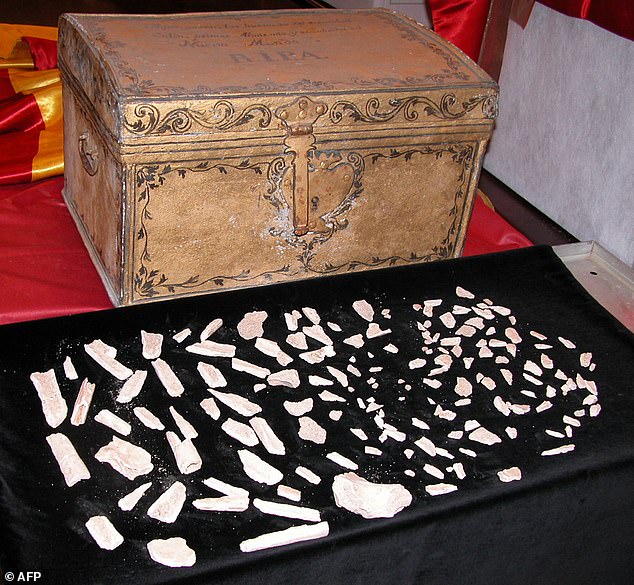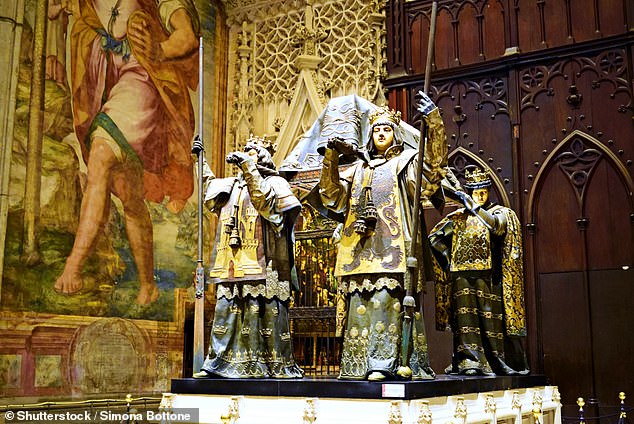Scientists join in as Christopher Columbus’ legacy is questioned with shocking new evidence
Scientists have cast doubt on a new documentary that made new claims about Christopher Columbus’ ethnic background.
The previously accepted theory was that Columbus was born in Genoa in 1451 to a family of wool weavers.
But a new documentary, broadcast on Saturday, claimed that new DNA analysis confirmed the explorer was a Spanish Jew.
Although the discovery would rewrite history, independent experts say they remain skeptical until the work is published with verifiable data.
The new DNA analysis claims to be the result of a 22-year study that analyzed Columbus’ genetics with those of his known relatives and descendants.
Scientists have raised concerns about a new DNA analysis that claimed Christopher Columbus was not Italian
It was based on research into 500-year-old remains of an unidentified person housed in a tomb buried in the Spanish cathedral of Seville, which the new analysis also determined belonged to Columbus.
Historical records show that Columbus was born Cristoforo Colombo to Susanna Fontanarossa and Domenico Colombo who lived in Genoa at the time, leading the world to believe he was of Italian descent.
However, Columbus’ son Ferdinand Columbus also made written statements that his father wanted to keep his true parentage a secret and recent DNA analysis could prove why.
The investigation was led by forensic expert Miguel Lorente, who made the findings public on Saturday in a documentary entitled ‘Columbus DNA: The True Origin’ on Spanish national broadcaster TVE.
‘We have DNA from Christopher Columbus, very partial, but enough. We have DNA from Hernando Colón, his son,” Lorente said in the program.
‘And in both Hernando’s Y chromosome (male) and mitochondrial DNA (transmitted from the mother) there are traits compatible with Jewish ancestry.’
Scientists have previously speculated that the explorer was likely born in Western Europe, possibly in the city of Valencia in Spain.
A defender of the Valencia theory, architect Francesc Albardaner, told Lorente in the documentary that Columbus paraded as a Christian because of the religious climate in Spain at the time.
In the 16th century, the Jewish population was decimated by a decree that forced them to convert to Christianity or be forced to leave the country.
And at least 30 percent chose to become Christians rather than flee their homes.
But geneticist Antonio Alonso, former head of the National Institute of Toxicology and Forensic Sciences, told El Pais that he was not convinced.
“Unfortunately, from a scientific point of view, no judgment can be made after watching the documentary because it does not provide data on what was analyzed,” Alonso said.
‘My conclusion is that the documentary does not show Columbus’ DNA at any point and that scientists do not know what analysis was carried out.’
The documentary begins in 2003, when Lorente and his team received permission to open a tomb in Seville, Spain, long believed to contain the remains of Christopher Columbus and those of his son.

A forensic scientist claimed that he studied Columbus’ bones in 2003 and found that there were not enough fragments to extract DNA from.
On Thursday, Lorente announced that their two-decade investigation had shown that the bone fragments belonged to the explorer.
Although scientists do not question who the remains belonged to, they do question the authenticity of the research.
Forensic anthropologist Miguel Botella previously analyzed the bone fragments in 2003 and spent six days studying them with laser scanners, but concluded there was not enough to perform a proper DNA analysis.
Ángel Carracedo of the University of Santiago de Compostela also looked at the bone fragments and said the DNA had been massively degraded.
But Lorente said in the documentary that he and his team “have a very partial DNA of Christopher Columbus, but it’s enough, and we have DNA of Hernando Columbus, who is confirmed to be his son.”
“What is very important in your theory is that both Hernando’s Y chromosome (inherited from the father) and the mitochondrial DNA (inherited from the mother) contain traits compatible with a Jewish ancestry,” he continued.
DailyMail.com has contacted Lorente for comment.

The DNA analysis was performed on bones found in a tomb of a Spanish cathedral
Although the new DNA analysis casts doubt on Columbus’s ancestral origins, Alonso said the research cannot overturn the idea that the explorer was born in Italy.
‘In any case, having a genealogy, a haplogroup or a haplotype of Jewish or Sephardic origin does not cast doubt on the birthplace of Columbus in Genoa, as stated by historical sources, nor does it tell us anything about the religious beliefs expressed by the generations of relatives near Columbus,” he said.
Columbus set sail from the Spanish port of Palos on August 3, 1492, hoping to find a route to the legendary riches of Asia.
Together with three ships, the Nina, the Pinta and the Santa Maria, Columbus and about a hundred men embarked on the journey that took them to the other side of the world – and far from their original destination.
On October 12, 1492, the ships made landfall in what is now the Bahamas and later that month Columbus saw Cuba and thought it was mainland China.
On the second voyage in 1493, Columbus deliberately sailed back to the New World and landed in Puerto Rico, where he enslaved many of the Taino people living on the island – some of whom were sent back to Spain.
Over the next four years, many Spaniards arrived, resulting in the deaths of approximately seven million Taino – 85 percent of the population.
